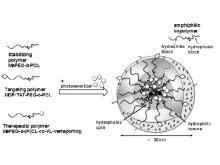BACKGROUND
Photodynamic therapy (PDT) can be used to treat a range of non-oncologic conditions as well as a number of solid tumors. It uses light, typically of infrared or visible wavelengths, to activate a localized photosensitizer that results in the selective destruction of unwanted cells. However, an important limitation is the low penetration depth of the employed electromagnetic radiation. Cherenkov light, which is generated when a charged particle passes through a dielectric, offers the possibility of deeper tissue penetration though its low intensity restricts its usefulness in PDT. If a means can be found to lower the required power of Cherenkov radiation needed to destroy cells, this would open up a practical, clinically useful version of PDT for the treatment of deep tissues.
TECHNOLOGY
Researchers at UHN and the University of Toronto have developed a modified version of PDT called Cherenkov-activated Nuclear-targeted Photodynamic Therapy (CHANT-PDT) for the treatment of deep tissues. This technique takes advantage of the enhanced lethality of nuclear localized photosensitizers to make Cherenkov-activated PDT feasible at clinically relevant conditions for the first time. In an illustrative example, the researchers constructed a nuclear-targeted polymeric micelle containing photosensitizers in the micelle core (Figure 1) and tested it on pancreatic cancer cells.

Figure 1. Illustrative example of a nanoparticle containing a targeting polymer and a therapeutic polymer for CHANT-PDT therapy.
COMPETITIVE ADVANTAGE
- Clinically useful strategy for photodynamic therapy of deep tissues
- Cherenkov light needed is ~ 100x less in intensity than usual due to nuclear targeting
- Cherenkov light needed is ~ 100x less in intensity than usual due to nuclear targeting
APPLICATIONS
- Treatment of deep tumors and tissues
INTELLECTUAL PROPERTY STATUS
- National Phase Filings (CA, EU, US)
PROJECT STATUS
Nanoparticles have been synthesized containing a nuclear targeting moiety and photosensitizers. Initial experiments have been conducted on pancreatic cancer cells where the efficacy of the techniques was assessed by damage to cellular DNA. Additional studies are currently being conducted to further develop the technique.





